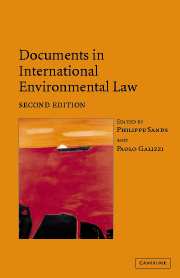Book contents
- Frontmatter
- Contents
- Preface
- PART I General instruments
- PART II Atmosphere
- PART III Oceans: global
- PART IIIB Oceans: regional
- PART IV Freshwater resources
- PART V Biodiversity
- PART VIA Hazardous substances and activities: nuclear
- PART VIB Hazardous substances and activities: pesticides
- PART VIC Hazardous substances and activities: waste
- PART VII Human rights and the environment
- PART VIII War and the environment
- 34 Convention on the Prohibition of Military or Any Other Hostile Use of Environmental Modification Techniques, 18 May 1977
- 35 Protocol I Additional to the Geneva Convention of 12 August 1949, and Relating to the Protection of Victims of International Armed Conflicts, 8 June 1977 (extracts)
- 36 United Nations Security Council Resolution 687, 3 April 1991 (extract)
- PART IX Trade and the environment
- PART X Environmental impact assessment and access to information
- PART XI Liability for environmental damage and breaches of environmental obligations
- PART XII The Antarctic
35 - Protocol I Additional to the Geneva Convention of 12 August 1949, and Relating to the Protection of Victims of International Armed Conflicts, 8 June 1977 (extracts)
Published online by Cambridge University Press: 05 June 2012
- Frontmatter
- Contents
- Preface
- PART I General instruments
- PART II Atmosphere
- PART III Oceans: global
- PART IIIB Oceans: regional
- PART IV Freshwater resources
- PART V Biodiversity
- PART VIA Hazardous substances and activities: nuclear
- PART VIB Hazardous substances and activities: pesticides
- PART VIC Hazardous substances and activities: waste
- PART VII Human rights and the environment
- PART VIII War and the environment
- 34 Convention on the Prohibition of Military or Any Other Hostile Use of Environmental Modification Techniques, 18 May 1977
- 35 Protocol I Additional to the Geneva Convention of 12 August 1949, and Relating to the Protection of Victims of International Armed Conflicts, 8 June 1977 (extracts)
- 36 United Nations Security Council Resolution 687, 3 April 1991 (extract)
- PART IX Trade and the environment
- PART X Environmental impact assessment and access to information
- PART XI Liability for environmental damage and breaches of environmental obligations
- PART XII The Antarctic
Summary
Editorial note
The Geneva Protocol I Additional to the Geneva Convention of 12 August 1949, Relating to the Protection of Victims of Armed Conflicts seeks to protect the environment by two techniques: (a) by setting standards and thresholds for permissible harm and (b) by establishing rules on targetry.
The Protocol expressly prohibits intentional harm to the environment and the utilisation of means and methods of warfare which ‘may be expected’ to cause such harm (Articles 35(3) and 55(1)). The threshold above which harm to the environment is proscribed is when it becomes ‘widespread, long-term and severe’ (Article 35(3)) and the population is threatened (Article 55(1)). All weapons, means and methods of warfare are required to be evaluated before use to determine their compliance with the Protocol and other international law (Article 36). Parties are required to take precautionary measures as attackers to minimise attacks on civilian objects (Article 57) and as defenders to protect civilian objects from the effects of military operations (Article 58).
In addition, the environment is protected by the prohibition on attacks on certain objects (Article 52). The Protocol prohibits attacks on objects deemed indispensable to civilian life, including foodstuffs, agricultural areas, crops, livestock and drinking water supplies (Article 54(2)). This immunity from attack is partially lifted if these objects provide sustenance or direct support of military forces (Article 54(3)) and derogations are permitted in defence of an invasion on a Party's own territory (Article 54(5)). The Protocol also protects dams, dykes and nuclear electrical generating stations from attack, subject to those objects not providing support for military operations (Article 56).
- Type
- Chapter
- Information
- Documents in International Environmental Law , pp. 989 - 997Publisher: Cambridge University PressPrint publication year: 2004
- 8
- Cited by



